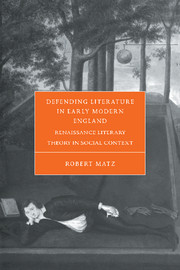Book contents
- Frontmatter
- Contents
- Acknowledgments
- 1 Introduction: “aut prodesse … aut delectare”
- 2 Recreating reading: Elyot's Boke Named the Governour
- 3 Heroic diversions: Sidney's Defence of Poetry
- 4 A “gentle discipline”: Spenser's Faerie Queene
- 5 Epilogue: from text to work?
- Notes
- Bibliography
- Index
- Cambridge Studies in Renaissance Literature and Culture
4 - A “gentle discipline”: Spenser's Faerie Queene
Published online by Cambridge University Press: 13 October 2009
- Frontmatter
- Contents
- Acknowledgments
- 1 Introduction: “aut prodesse … aut delectare”
- 2 Recreating reading: Elyot's Boke Named the Governour
- 3 Heroic diversions: Sidney's Defence of Poetry
- 4 A “gentle discipline”: Spenser's Faerie Queene
- 5 Epilogue: from text to work?
- Notes
- Bibliography
- Index
- Cambridge Studies in Renaissance Literature and Culture
Summary
The poet as Medina
The “generall end” of The Faerie Queene, Spenser writes in the letter to Ralegh, is to “fashion a gentleman or noble person in vertuous and gentle discipline.” Given the multiple definitions of aristocratic conduct available to Spenser, however, this “generall end” is by no means clear. It is in this regard that I suggest we read book 2 of The Faerie Queene, the Book of Temperance, as central to the project of The Faerie Queene and, more broadly, to the socially and culturally mediating Horatian poetics detailed in this book. For temperance – etymologically a “mixing” – could be regarded as the paradigmatic virtue of The Faerie Queene's didactic allegory, which blends divergent codes of aristocratic behavior in its various layers of meaning, and mixes pleasure and profit through its effects on the reader. Spenser's lesson in “gentle discipline” hints at this mixture in its yoking of courtly (“gentle” or refined) and Protestant-humanist (discipline) codes; it also hints at a more pointed assertion that the gentility must discipline itself, along with a reassuring promise that this discipline will nonetheless be gentle, that it will partake neither of the socially demeaning “tediousness” eschewed even by a Protestant-identified aristocrat such as Sidney, nor of the abrasive Protestant moralism of a Stephen Gosson, which Sidney likewise rejected.
Forwarding a program of “gentle discipline” to aristocratic readers who maintain their class position through their work and their courtly pleasure, Spenser situates The Faerie Queene's didactic allegory within fraught conjunctions between kinds of aristocratic behavior.
- Type
- Chapter
- Information
- Defending Literature in Early Modern EnglandRenaissance Literary Theory in Social Context, pp. 88 - 127Publisher: Cambridge University PressPrint publication year: 2000



